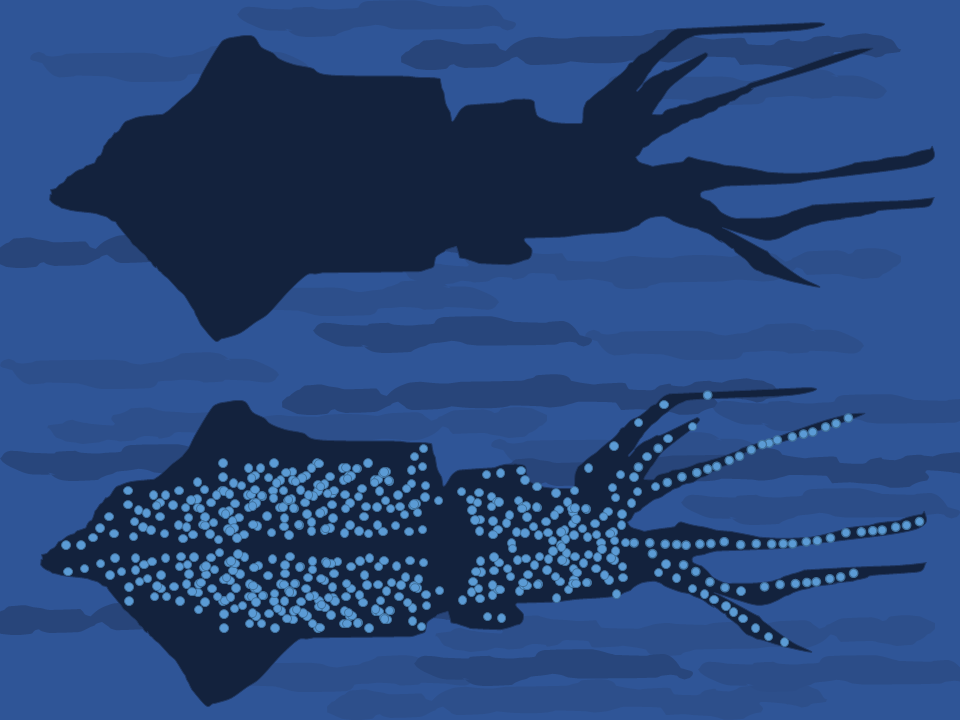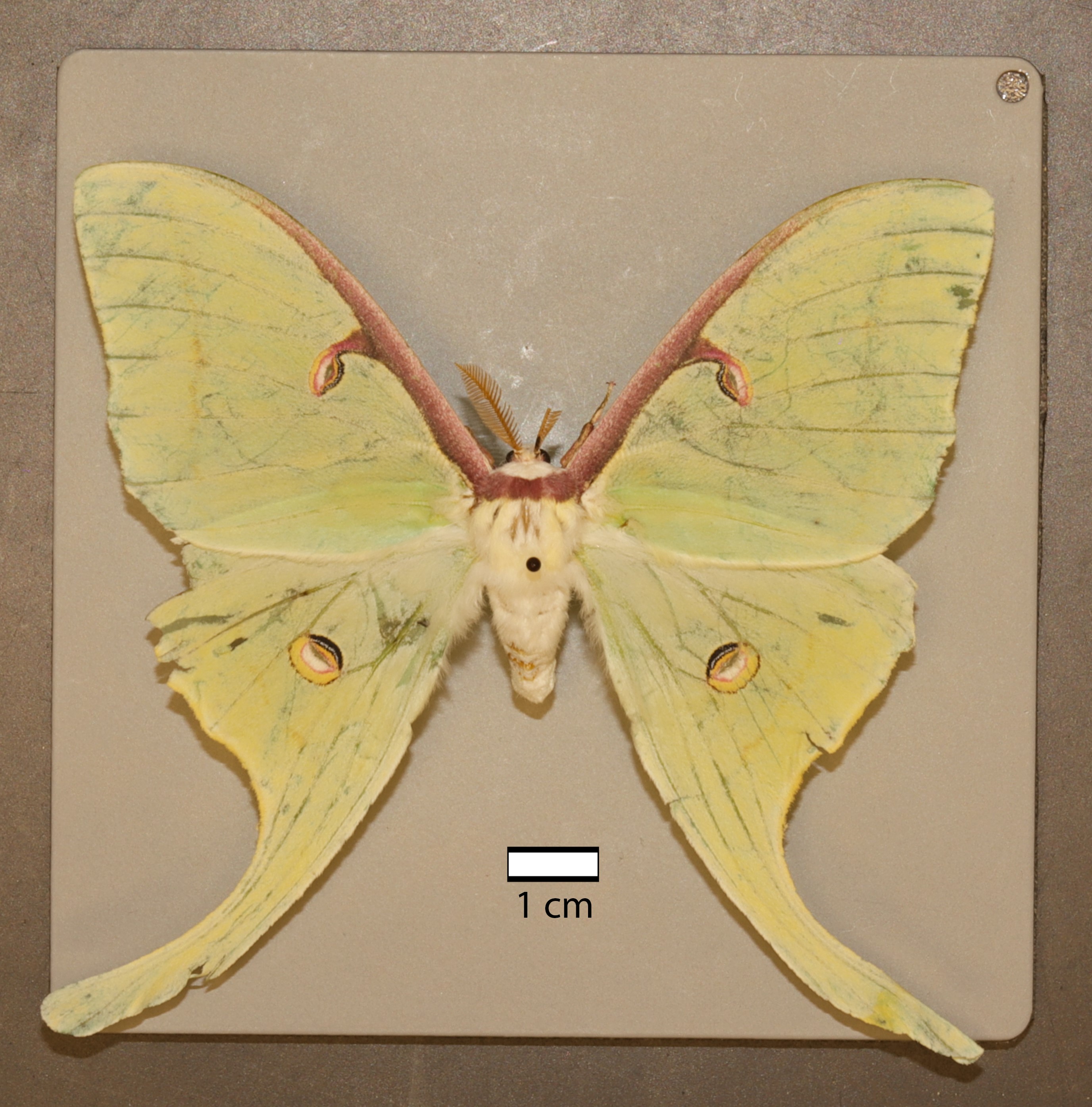 |
Countershading
Countershading, or Thayer's law, is a method of camouflage in which animal coloration, an animal's coloration is darker on the top or upper side and lighter on the underside of the body. This pattern is found in many species of mammals, reptiles, birds, fish, and insects, both in predators and in prey. When light falls from above on a uniformly coloured three-dimensional object such as a sphere, it makes the upper side appear lighter and the underside darker, grading from one to the other. This pattern of light and shade makes the object appear solid, and therefore easier to detect. The classical form of countershading, discovered in 1909 by the artist Abbott Handerson Thayer, works by counterbalancing the effects of self-shadowing, again typically with grading from dark to light. In theory this could be useful for military camouflage, but in practice it has rarely been applied, despite the best efforts of Thayer and, later, in the Second World War, of the zoologist Hugh Cott. ... [...More Info...] [...Related Items...] OR: [Wikipedia] [Google] [Baidu] |
 |
Camouflage
Camouflage is the use of any combination of materials, coloration, or illumination for concealment, either by making animals or objects hard to see, or by disguising them as something else. Examples include the leopard's spotted coat, the battledress of a modern soldier, and the leaf-mimic katydid's wings. A third approach, motion dazzle, confuses the observer with a conspicuous pattern, making the object visible but momentarily harder to locate. The majority of camouflage methods aim for crypsis, often through a general resemblance to the background, high contrast disruptive coloration, eliminating shadow, and countershading. In the open ocean, where there is no background, the principal methods of camouflage are transparency, silvering, and countershading, while the bioluminescence, ability to produce light is among other things used for counter-illumination on the undersides of cephalopods such as squid. Some animals, such as chameleons and octopuses, are capable of Active ... [...More Info...] [...Related Items...] OR: [Wikipedia] [Google] [Baidu] |
 |
Counter-illumination
Counter-illumination is a method of active camouflage seen in marine animals such as firefly squid and midshipman fish, and in military prototypes, producing light to match their backgrounds in both brightness and wavelength. Marine animals of the mesopelagic (mid-water) zone tend to appear dark against the bright water surface when seen from below. They can camouflage themselves, often anti-predator adaptation, from predators but also from their prey, by producing light with bioluminescence, bioluminescent photophores on their downward-facing surfaces, reducing the contrast of their silhouettes against the background. The light may be produced by the animals themselves, or by mutualism (biology), symbiotic bacteria, often ''Aliivibrio fischeri''. Counter-illumination differs from countershading, which uses only pigments such as melanin to reduce the appearance of shadows. It is one of the dominant types of aquatic camouflage, along with transparency and silvering (camouflage), ... [...More Info...] [...Related Items...] OR: [Wikipedia] [Google] [Baidu] |
 |
Abbott Handerson Thayer
Abbott Handerson Thayer (August 12, 1849May 29, 1921) was an American painter, naturalist, and teacher. As a painter of portraits, figures, animals, and landscapes, he enjoyed a certain prominence during his lifetime, and his paintings are represented in major American art collections. He is perhaps best known for his 'angel' paintings, some of which use his children as models. During the last third of his life, he worked together with his son, Gerald Handerson Thayer, on a book about protective coloration in nature, titled '' Concealing-Coloration in the Animal Kingdom''. First published by Macmillan in 1909, then reissued in 1918, it may have had an effect on military camouflage during World War I. However it was roundly mocked by Theodore Roosevelt and others for its assumption that all animal coloration is cryptic. Thayer also influenced American art through his efforts as a teacher, training apprentices in his New Hampshire studio. Early life Thayer was born in Boston t ... [...More Info...] [...Related Items...] OR: [Wikipedia] [Google] [Baidu] |
|
Military Camouflage
Military camouflage is the use of camouflage by an Military, armed force to protect personnel and equipment from observation by enemy forces. In practice, this means applying colour and materials to military equipment of all kinds, including vehicles, ships, aircraft, gun positions and battledress, either to conceal it from observation (crypsis), or to make it appear as something else (mimicry). The French slang word ''wikt:camouflage, camouflage'' came into common English usage during World War I when the concept of visual deception developed into an essential part of modern military tactics. In that war, long-range artillery and observation from the air combined to expand the field of fire, and camouflage was widely used to decrease the danger of being targeted or enable surprise. As such, military camouflage is a form of military deception in addition to cultural functions such as political identification. Camouflage was first practiced in simple form in the mid 18th centur ... [...More Info...] [...Related Items...] OR: [Wikipedia] [Google] [Baidu] |
|
 |
Hugh Cott
Hugh Bamford Cott (6 July 1900 – 18 April 1987) was a British zoologist, an authority on both natural and military camouflage, and a scientific illustrator and photographer. Many of his field studies took place in Africa, where he was especially interested in the Nile crocodile, the evolution of pattern and colour in animals. During the World War II, Second World War, Cott worked as a camouflage expert for the British Army and helped to influence War Office policy on camouflage. His book ''Adaptive Coloration in Animals'' (1940), popular among serving soldiers, was the major textbook on camouflage in zoology of the twentieth century. After the war, he became a Fellow of Selwyn College, Cambridge. As a Fellow of the Zoological Society of London, he undertook expeditions to Africa and the Amazon to collect specimens, mainly reptiles and amphibians. Life and career Cott was born in Ashby Magna, Leicestershire, England, on 6 July 1900; his father was the Rector (ecclesiastical), ... [...More Info...] [...Related Items...] OR: [Wikipedia] [Google] [Baidu] |
 |
Animal Coloration
Animal coloration is the general appearance of an animal resulting from the reflection or emission of light from its surfaces. Some animals are brightly coloured, while others are hard to see. In some species, such as the peafowl, the male has strong patterns, conspicuous colours and is iridescent, while the female is far less visible. There are several separate reasons why animals have evolved colours. Camouflage enables an animal to remain hidden from view. Animals use colour to advertising in biology, advertise services such as cleaning symbiosis, cleaning to animals of other species; to signalling theory, signal their Sexual selection, sexual status to other members of the same species; and in mimicry, taking advantage of the aposematism, warning coloration of another species. Some animals use flashes of colour to divert attacks by deimatic behaviour, startling predators. Zebras may possibly use motion dazzle, confusing a predator's attack by moving a bold pattern rapidly ... [...More Info...] [...Related Items...] OR: [Wikipedia] [Google] [Baidu] |
 |
Squid
A squid (: squid) is a mollusc with an elongated soft body, large eyes, eight cephalopod limb, arms, and two tentacles in the orders Myopsida, Oegopsida, and Bathyteuthida (though many other molluscs within the broader Neocoleoidea are also called ''squid'' despite not strictly fitting these criteria). Like all other cephalopods, squid have a distinct head, Symmetry (biology)#Bilateral symmetry, bilateral symmetry, and a mantle (mollusc), mantle. They are mainly soft-bodied, like octopuses, but have a small internal skeleton in the form of a rod-like gladius (cephalopod), gladius or pen, made of chitin. Squid diverged from other cephalopods during the Jurassic and occupy a similar Ecological niche, role to teleost fish as open-water predators of similar size and behaviour. They play an important role in the open-water food web. The two long tentacles are used to grab prey and the eight arms to hold and control it. The beak then cuts the food into suitable size chunks for swal ... [...More Info...] [...Related Items...] OR: [Wikipedia] [Google] [Baidu] |
 |
Bioluminescence
Bioluminescence is the emission of light during a chemiluminescence reaction by living organisms. Bioluminescence occurs in multifarious organisms ranging from marine vertebrates and invertebrates, as well as in some Fungus, fungi, microorganisms including some bioluminescent bacteria, Dinoflagellate, dinoflagellates and terrestrial arthropods such as Firefly, fireflies. In some animals, the light is bacteriogenic, produced by symbiosis, symbiotic bacteria such as those from the genus ''Vibrio''; in others, it is autogenic, produced by the animals themselves. In most cases, the principal chemical reaction in bioluminescence involves the reaction of a substrate called luciferin and an enzyme, called luciferase. Because these are generic names, luciferins and luciferases are often distinguished by the species or group, e.g. firefly luciferin or Vargulin, cypridina luciferin. In all characterized cases, the enzyme Catalysis, catalyzes the Redox, oxidation of the luciferin resultin ... [...More Info...] [...Related Items...] OR: [Wikipedia] [Google] [Baidu] |
 |
Aposematism
Aposematism is the Advertising in biology, advertising by an animal, whether terrestrial or marine, to potential predation, predators that it is not worth attacking or eating. This unprofitability may consist of any defenses which make the prey difficult to kill and eat, such as toxicity, venom, foul taste or smell, sharp spines, or aggressive nature. These advertising signals may take the form of conspicuous animal coloration, coloration, sounds, odours, or other perception, perceivable characteristics. Aposematic Signalling theory, signals are beneficial for both predator and prey, since both avoid potential harm. The term was coined in 1877 by Edward Bagnall Poulton for Alfred Russel Wallace's concept of warning coloration. Aposematism is exploited in Müllerian mimicry, where species with strong defences evolve to resemble one another. By mimicking similarly coloured species, the warning signal to predators is shared, causing them to learn more quickly at less of a cost. ... [...More Info...] [...Related Items...] OR: [Wikipedia] [Google] [Baidu] |
 |
England
England is a Countries of the United Kingdom, country that is part of the United Kingdom. It is located on the island of Great Britain, of which it covers about 62%, and List of islands of England, more than 100 smaller adjacent islands. It shares Anglo-Scottish border, a land border with Scotland to the north and England–Wales border, another land border with Wales to the west, and is otherwise surrounded by the North Sea to the east, the English Channel to the south, the Celtic Sea to the south-west, and the Irish Sea to the west. Continental Europe lies to the south-east, and Ireland to the west. At the 2021 United Kingdom census, 2021 census, the population was 56,490,048. London is both List of urban areas in the United Kingdom, the largest city and the Capital city, capital. The area now called England was first inhabited by modern humans during the Upper Paleolithic. It takes its name from the Angles (tribe), Angles, a Germanic peoples, Germanic tribe who settled du ... [...More Info...] [...Related Items...] OR: [Wikipedia] [Google] [Baidu] |
 |
Luna Moth
The luna moth (''Actias luna''), also called the American moon moth, is a Nearctic moth in the family Saturniidae, subfamily Saturniinae, a group commonly named the giant silk moths. The moth has lime-green wings and a white body. Its caterpillars are also green. Its typical wingspan is roughly , but wingspans can exceed , ranking the species as one of the larger moths in North America. Across Canada, it has one generation per year, with the winged adults appearing in late May or early June, whereas farther south it will have two or even three generations per year, the first appearance as early as March in southern parts of the United States. As defense mechanisms, larvae emit clicks as a warning and can also regurgitate intestinal contents, confirmed as having a deterrent effect on a variety of predators. The elongated tails of the hindwings are thought to confuse the echolocation detection used by predatory bats. A parasitoid fly deliberately introduced to North A ... [...More Info...] [...Related Items...] OR: [Wikipedia] [Google] [Baidu] |